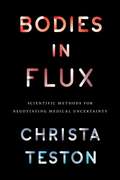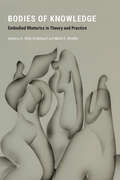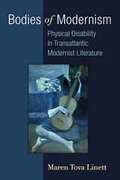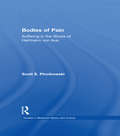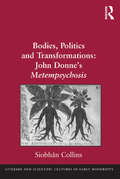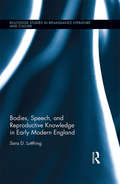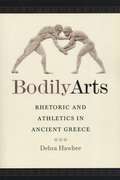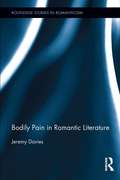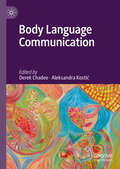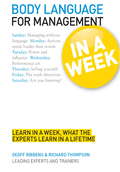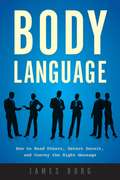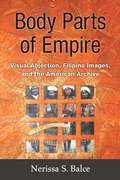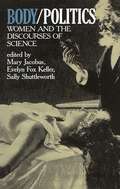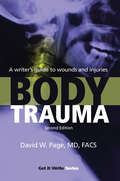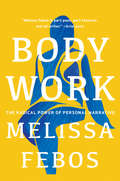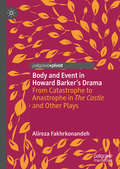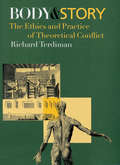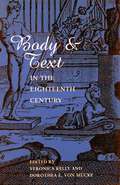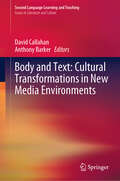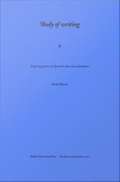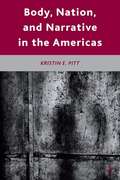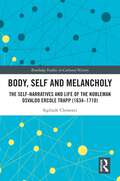- Table View
- List View
Bodies in Flux: Scientific Methods for Negotiating Medical Uncertainty
by Christa TestonDoctors, scientists, and patients have long grappled with the dubious nature of “certainty” in medical practice. To help navigate the chaos caused by ongoing bodily change we rely on scientific reductions and deductions. We take what we know now and make best guesses about what will be. But bodies in flux always outpace the human gaze. Particularly in cancer care, processes deep within our bodies are at work long before we even know where to look. In the face of constant biological and technological change, how do medical professionals ultimately make decisions about care? Bodies in Flux explores the inventive ways humans and nonhumans work together to manufacture medical evidence. Each chapter draws on rhetorical theory to investigate a specific scientific method for negotiating medical uncertainty in cancer care, including evidential visualization, assessment, synthesis, and computation. Case studies unveil how doctors rely on visuals when deliberating about a patient’s treatment options, how members of the FDA use inferential statistics to predict a drug’s effectiveness, how researchers synthesize hundreds of clinical trials into a single evidence-based recommendation, and how genetic testing companies compute and commoditize human health. Teston concludes by advocating for an ethic of care that pushes back against the fetishization of certainty—an ethic of care that honors human fragility and bodily flux.
Bodies in Flux: Scientific Methods for Negotiating Medical Uncertainty
by Christa TestonDoctors, scientists, and patients have long grappled with the dubious nature of “certainty” in medical practice. To help navigate the chaos caused by ongoing bodily change we rely on scientific reductions and deductions. We take what we know now and make best guesses about what will be. But bodies in flux always outpace the human gaze. Particularly in cancer care, processes deep within our bodies are at work long before we even know where to look. In the face of constant biological and technological change, how do medical professionals ultimately make decisions about care? Bodies in Flux explores the inventive ways humans and nonhumans work together to manufacture medical evidence. Each chapter draws on rhetorical theory to investigate a specific scientific method for negotiating medical uncertainty in cancer care, including evidential visualization, assessment, synthesis, and computation. Case studies unveil how doctors rely on visuals when deliberating about a patient’s treatment options, how members of the FDA use inferential statistics to predict a drug’s effectiveness, how researchers synthesize hundreds of clinical trials into a single evidence-based recommendation, and how genetic testing companies compute and commoditize human health. Teston concludes by advocating for an ethic of care that pushes back against the fetishization of certainty—an ethic of care that honors human fragility and bodily flux.
Bodies of Knowledge: Embodied Rhetorics in Theory and Practice
by Marie E. Moeller A. Abby KnoblauchBodies of Knowledge challenges homogenizing (mis)understandings of knowledge construction and provides a complex discussion of what happens when we do not attend to embodied rhetorical theories and practices. Because language is always a reflection of culture, to attempt to erase language and knowledge practices that reflect minoritized and historically excluded cultural experiences obscures the legitimacy of such experiences both within and outside the academy. The pieces in Bodies of Knowledge draw explicit attention to the impact of the body on text, the impact of the body in text, the impact of the body as text, and the impact of the body upon textual production. The contributors investigate embodied rhetorics through the lenses of race and ethnicity, gender and sexuality, disability and pain, technologies and ecologies, clothing and performance, and scent, silence, and touch. In doing so, they challenge the (false) notion that academic knowledge—that is, “real” knowledge—is disembodied and therefore presumed white, middle class, cis-het, able-bodied, and male. This collection lays bare how myriad bodies invent, construct, deliver, and experience the processes of knowledge building. Experts in the field of writing studies provide the necessary theoretical frameworks to better understand productive (and unproductive) uses of embodied rhetorics within the academy and in the larger social realm. To help meet the theoretical and pedagogical needs of the discipline, Bodies of Knowledge addresses embodied rhetorics and embodied writing more broadly though a rich, varied, and intersectional approach. These authors address larger questions around embodiment while considering the various impacts of the body on theories and practices of rhetoric and composition. Contributors: Scot Barnett, Margaret Booker, Katherine Bridgman, Sara DiCaglio, Kristie S. Fleckenstein, Vyshali Manivannan, Temptaous Mckoy, Julie Myatt, Julie Nelson, Ruth Osorio, Kate Pantelides, Caleb Pendygraft, Nadya Pittendrigh, Kellie Sharp-Hoskins, Anthony Stagliano, Megan Strom
Bodies of Modernism: Physical Disability in Transatlantic Modernist Literature
by Maren LinettBodies of Modernism brings a new and exciting analytical lens to modernist literature, that of critical disability studies. The book offers new readings of canonical and noncanonical writers from both sides of the Atlantic including Flannery O'Connor, Eudora Welty, H. G. Wells, D. H. Lawrence, Elizabeth Bowen, Henry Green, Olive Moore, Carson McCullers, Tennessee Williams, J. M. Synge, Florence Barclay, Virginia Woolf, and James Joyce. Through readings of this wide range of texts and with chapters focusing on mobility impairments, deafness, blindness, and deformity, the study reveals both modernism's skepticism about and dependence on fantasies of whole, "normal" bodies.
Bodies of Pain: Suffering in the Works of Hartmann von Aue (Studies in Medieval History and Culture #11)
by Scott E. PincikowskiFirst Published in 2002. Routledge is an imprint of Taylor & Francis, an informa company.
Bodies, Politics and Transformations: John Donne's Metempsychosis
by Siobhán CollinsSince the beginning of the twentieth century, critics have predominantly offered a negative estimate of John Donne’s Metempsychosis. In contrast, this study of Metempsychosis re-evaluates the poem as one of the most vital and energetic of Donne’s canon. Siobhán Collins appraises Metempsychosis for its extraordinary openness to and its inventive portrayal of conflict within identity. She situates this ludic verse as a text alert to and imbued with the Elizabethan fascination with the processes and properties of metamorphosis. Contesting the pervasive view that the poem is incomplete, this study illustrates how Metempsychosis is thematically linked with Donne’s other writings through its concern with the relationship between body and soul, and with temporality and transformation. Collins uses this genre-defying verse as a springboard to contribute significantly to our understanding of early modern concerns over the nature and borders of human identity, and the notion of selfhood as mutable and in process. Drawing on and contributing to recent scholarly work on the history of the body and on sexuality in the early modern period, Collins argues that Metempsychosis reveals the oft-violent processes of change involved in the author’s personal life and in the intellectual, religious and political environment of his time. She places the poem’s somatic representations of plants, beasts and humans within the context of early modern discourses: natural philosophy, medical, political and religious. Collins offers a far-reaching exploration of how Metempsychosis articulates philosophical inquiries that are central to early modern notions of self-identity and moral accountability, such as: the human capacity for autonomy; the place of the human in the ’great chain of being’; the relationship between cognition and embodiment, memory and selfhood; and the concept of wonder as a distinctly human phenomenon.
Bodies, Speech, and Reproductive Knowledge in Early Modern England (Routledge Studies in Renaissance Literature and Culture)
by Sara D. LuttfringThis volume examines early modern representations of women’s reproductive knowledge through new readings of plays, monstrous birth pamphlets, medical treatises, court records, histories, and more, which are often interpreted as depicting female reproductive bodies as passive, silenced objects of male control and critique. Luttfring argues instead that these texts represent women exercising epistemological control over reproduction through the stories they tell about their bodies and the ways they act these stories out, combining speech and physical performance into what Luttfring calls 'bodily narratives.' The power of these bodily narratives extends beyond knowledge of individual bodies to include the ways that women’s stories about reproduction shape the patriarchal identities of fathers, husbands, and kings. In the popular print and theater of early modern England, women’s bodies, women’s speech, and in particular women’s speech about their bodies perform socially constitutive work: constructing legible narratives of lineage and inheritance; making and unmaking political alliances; shaping local economies; and defining/delimiting male socio-political authority in medical, royal, familial, judicial, and economic contexts. This book joins growing critical discussion of how female reproductive bodies were used to represent socio-political concerns and will be of interest to students and scholars working in early modern literature and culture, women’s history, and the history of medicine.
Bodily Arts
by Debra HawheeThe role of athletics in ancient Greece extended well beyond the realms of kinesiology, competition, and entertainment. In teaching and philosophy, athletic practices overlapped with rhetorical ones and formed a shared mode of knowledge production. Bodily Arts examines this intriguing intersection, offering an important context for understanding the attitudes of ancient Greeks toward themselves and their environment. In classical society, rhetoric was an activity, one that was in essence "performed. " Detailing how athletics came to be rhetoric's "twin art" in the bodily aspects of learning and performance, Bodily Arts draws on diverse orators and philosophers such as Isocrates, Demosthenes, and Plato, as well as medical treatises and a wealth of artifacts from the time, including statues and vases. Debra Hawhee's insightful study spotlights the notion of a classical gymnasium as the location for a habitual "mingling" of athletic and rhetorical performances, and the use of ancient athletic instruction to create rhetorical training based on rhythm, repetition, and response. Presenting her data against the backdrop of a broad cultural perspective rather than a narrow disciplinary one, Hawhee presents a pioneering interpretation of Greek civilization from the sixth, fifth, and fourth centuries BCE by observing its citizens in action.
Bodily Pain in Romantic Literature (Routledge Studies in Romanticism)
by Jeremy DaviesShortlisted for the University English Early Career Book Prize 2016 Shortlisted for the British Association for Romantic Studies First Book Prize 2015 When writers of the late eighteenth and early nineteenth centuries explored the implications of organic and emotional sensitivity, the pain of the body gave rise to unsettling but irresistible questions. Urged on by some of their most deeply felt preoccupations – and in the case of figures like Coleridge and P. B. Shelley, by their own experiences of chronic pain – many writers found themselves drawn to the imaginative scrutiny of bodies in extremis. Bodily Pain in Romantic Literature reveals the significance of physical hurt for the poetry, philosophy, and medicine of the Romantic period. This study looks back to eighteenth-century medical controversies that made pain central to discussions about the nature of life, and forward to the birth of surgical anaesthesia in 1846. It examines why Jeremy Bentham wrote in defence of torture, and how pain sparked the imagination of thinkers from Adam Smith to the Marquis de Sade. Jeremy Davies brings to bear on Romantic studies the fascinating recent work in the medical humanities that offers a fresh understanding of bodily hurt, and shows how pain could prompt new ways of thinking about politics, ethics, and identity.
Body Language Communication
by Derek Chadee Aleksandra KostićThis book explores a number of important themes within body language discourse. The authors analyse the role of hands, touch, facial expression, misconceptions, and fallacious arguments in body language training. Other issues addressed include body language between humans and machines, lie detection, reactance and body language and thermography of the face. The authors work to determine various potentials of body language, and assess some areas of body language and role of body language in everyday life. They also discuss new perspectives and future directions in body language studies.
Body Language for Management in a Week: Teach Yourself (Teach Yourself In A Week Ser.)
by Richard Thompson Geoff RibbensThe ability to read people's body language and send out the right signals yourself, is crucial to anyone who wants to advance their career.Written by Geoff Ribbens and Richard Thompson, leading experts on body language, this book quickly teaches you the insider secrets you need to know to in order give a successful appraisal.The highly motivational 'in a week' structure of the book provides seven straightforward chapters explaining the key points, and at the end there are optional questions to ensure you have taken it all in. There are also cartoons and diagrams throughout, to help make this book a more enjoyable and effective learning experience.So what are you waiting for? Let this book put you on the fast track to success!
Body Language for Management in a Week: Teach Yourself (Teach Yourself In A Week Ser.)
by Richard Thompson Geoff RibbensThe ability to read people's body language and send out the right signals yourself, is crucial to anyone who wants to advance their career.Written by Geoff Ribbens and Richard Thompson, leading experts on body language, this book quickly teaches you the insider secrets you need to know to in order give a successful appraisal.The highly motivational 'in a week' structure of the book provides seven straightforward chapters explaining the key points, and at the end there are optional questions to ensure you have taken it all in. There are also cartoons and diagrams throughout, to help make this book a more enjoyable and effective learning experience.So what are you waiting for? Let this book put you on the fast track to success!
Body Language: How to Read Others, Detect Deceit, and Convey the Right Message
by James BorgBody language is a vital part of everyday communication, but more often than not, we are unaware of the messages our bodies are sending to others. Body Language will teach you to become more aware of these issues. In seven lessons, you will not only learn to read others, but also learn to control your own posture to send the correct message to those around you. This guide will help you: Make a good first impression Match your words to your body posture Read facial expressions, and decipher meaning from the eyes and tone of voice Understand what certain postures, such as folded arms and crossed legs, mean Quickly discern if someone is lying
Body Parts of Empire: Visual Abjection, Filipino Images, and the American Archive
by Nerissa BalceBody Parts of Empire is a study of abjection in American visual culture and popular literature from the Philippine-American War (1899-1902). During this period, the American national territory expanded beyond its continental borders to islands in the Pacific and the Caribbean. Simultaneously, new technologies of vision emerged for imagining the human body, including the moving camera, stereoscopes, and more efficient print technologies for mass media. Rather than focusing on canonical American authors who wrote at the time of U.S. imperialism, this book examines abject texts--images of naked savages, corpses, clothed native elites, and uniformed American soldiers--as well as bodies of writing that document the goodwill and violence of American expansion in the Philippine colony. Contributing to the fields of American studies, Asian American studies, and gender studies, the book analyzes the actual archive of the Philippine-American War and how the racialization and sexualization of the Filipino colonial native have always been part of the cultures of America and U.S. imperialism. By focusing on the Filipino native as an abject body of the American imperial imaginary, this study offers a historical materialist optic for reading the cultures of Filipino America.
Body Politics: Women, Literature, and the Discourse of Science
by Sally Shuttleworth Evelyn F. Keller Mary JacobusThis groundbreaking collection addresses such scientific issues as artificial fertilization, the "crisis" in childbirth management, the medical invention of "female" maladies, and the debates surrounding them.
Body Trauma
by David W. PageBody Trauma explains what happens to body organs and bones maimed by accident or intent and the small window of opportunity for emergency treatment. Research what happens in a hospital operating room and the personnel who initiate treatment. Use these facts to bring added realism to your stories and novels.
Body Work: The Radical Power of Personal Narrative
by Melissa FebosMemoir meets craft masterclass in this “daring, honest, psychologically insightful” exploration of how we think and write about intimate experiences—“a must read for anybody shoving a pen across paper or staring into a screen or a past" (Mary Karr). <p><p> In this bold and exhilarating mix of memoir and master class, Melissa Febos tackles the emotional, psychological, and physical work of writing intimately while offering an utterly fresh examination of the storyteller’s life and the questions which run through it. <p><p> How might we go about capturing on the page the relationships that have formed us? How do we write about our bodies, their desires and traumas? What does it mean for an author’s way of writing, or living, to be dismissed as “navel-gazing”—or else hailed as “so brave, so raw”? And to whom, in the end, do our most intimate stories belong? <p><p> Drawing on her own path from aspiring writer to acclaimed author and writing professor—via addiction and recovery, sex work and academia—Melissa Febos has created a captivating guide to the writing life, and a brilliantly unusual exploration of subjectivity, privacy, and the power of divulgence. Candid and inspiring, Body Work will empower readers and writers alike, offering ideas—and occasional notes of caution—to anyone who has ever hoped to see themselves in a story.
Body and Event in Howard Barker's Drama: From Catastrophe to Anastrophe in The Castle and Other Plays
by Alireza FakhrkonandehThis book explores questions of gender, desire, embodiment, and language in Barker’s oeuvre. With The Castle as a focal point, the scope extends considerably beyond this play to incorporate analysis and exploration of the Theatre of Catastrophe; questions of gender, subjectivity and desire; God/religion; aesthetics of the self; autonomy-heteronomy; ethics; and the relation between political and libidinal economy, at stake in 20 other plays by Barker (including Rome, The Power of the Dog, The Bite of the Night, Judith, Possibilities, I Saw Myself, Fence in Its Thousandth Year, The Gaoler’s Ache for the Nearly Dead, The Brilliance of the Servant, Golgo, among others).
Body and Story: The Ethics and Practice of Theoretical Conflict
by Richard TerdimanIn Body and Story, Richard Terdiman explores the tension between what might seem to be two fundamentally different ways of understanding the world: as physical reality and as representation in language. In demonstrating the complicated relationship between these two modes of being, he also presents a new bold approach to the problem of conflicts between irreconcilable but equally compelling theoretical ideas. Enlightenment rationalism is most often understood as maintaining that words can meaningfully refer to and grasp things in the material world, while Postmodernism famously argues that nothing exists outside of language. Terdiman challenges this clean distinction, finding the early seeds of Postmodern doubt in the Enlightenment, and demonstrating the stubborn resistance of material reality—particularly that of the body—to language even today. Building on readings of works by 18th-century encyclopedist Denis Diderot and contemporary philosopher-icon Jacques Derrida, Terdiman argues that despite their genuine and profound opposition, a constant negotiation or mutual interrogation has always been taking place between these two world-views, even as the balance at times shifts to one side or the other. In analyzing these shifts he proposes a new model for understanding how seemingly unabridgeable theories legitimately coexist in our intellectual conception of the world, and he suggests a new ethics for managing this coexistence.
Body and Text in the Eighteenth Century
by Veronica KellyTwelve scholars from the fields of English, French, and German literature here examine the complex ways in which the human body becomes the privileged semiotic model through which eighteenth-century culture defines its political and conceptual centers. In making clear that the deployment of the body varies tremendously depending on what is meant by the 'human body', the essays draw on popular literature, poetics and aesthetics, garden architecture, physiognomy, beauty manuals, pornography and philosophy, as well as on canonical works in the genres of the novel and the drama.
Body and Text: Cultural Transformations in New Media Environments (Second Language Learning and Teaching)
by David Callahan Anthony BarkerThis book presents a collection of academic essays that take a fresh look at content and body transformation in the new media, highlighting how old hierarchies and canons of analysis must be revised. The movement of narratives and characterisations across forms, conventionally understood as adaptation, has commonly involved high-status classical forms (drama, epic, novel) being transformed into recorded and broadcast media (film, radio and television), or from the older recorded media to the newer ones. The advent of convergent digital platforms has further transformed hierarchies, and the formation of global conglomerates has created the commercial conditions for ever more lucrative exchanges between different media. Now source texts can move in any direction and take up any configuration, as emerging interacting fan bases drive innovation and new creative and commercial possibilities are deployed. Moreover, transformation may be not just a technology-driven creative practice and response, but at the very centre of the thematic worlds developed in those forms of story-telling which are currently popular: television series, video games, films and novels. The magic transformation of “your” money into “their” money is paralleled in contemporary media and culture by the centrality of transformation of one product to another as a media industry practice, as well as the transformation of bodies as a major theme both in the ensuing media products and in people’s identity practices in daily life.
Body of Vision
by Michael SindingIn Body of Vision, Michael Sinding connects Northrop Frye's groundbreaking contributions to our understanding of the human imagination with cognitive poetics - the cutting-edge school of literary criticism that applies the principles of cognitive science to the interpretation of literary texts and contexts. Sinding undertakes this task through analyses of the interplay of metaphoric and narrative schemas in several forms of cultural mythology.Sinding identifies the profound connections between cognitive views of language, literature, and culture and Frye's views by exploring three related aspects of Frye's work - meaning and thought, culture and society, and literary history. He investigates these connections through detailed studies of major cultural texts including Dante's Divine Comedy, Hobbes' Leviathan, Rousseau's Social Contract, and Milton's "Lycidas." By linking Frye's classic studies to exciting recent approaches in the humanities and the cognitive revolution of the past few decades, Body of Vision casts Frye's achievements in a fascinating new light.
Body of Writing: Figuring Desire in Spanish American Literature
by René PrietoBody of Writing focuses on the traces that an author's "body" leaves on a work of fiction. Drawing on the work of six important Spanish American writers of the twentieth century, Ren Prieto examines narratives that reflect--in differing yet ultimately complementary ways--the imprint of the author's body, thereby disclosing insights about power, aggression, transgression, and eroticism. Healthy, invalid, lustful, and confined bodies--as portrayed by Julio Cortzar, Guillermo Cabrera Infante, Gabriel Garca Mrquez, Severo Sarduy, Rosario Castellanos, and Tununa Mercado--become evidence for Roland Barthes's contention that works of fiction are "anagrams of the body. " Claiming that an author's intentions can be uncovered by analyzing "the topography of a text," Prieto pays particular attention not to the actions or plots of these writers' fiction but rather to their settings and characterizations. In the belief that bodily traces left on the page reveal the motivating force behind a writer's creative act, he explores such fictional themes as camouflage, deterioration, defilement, entrapment, and subordination. Along the way, Prieto reaches unexpected conclusions regarding topics that include the relationship of the female body to power, male and female transgressive impulses, and the connection between aggression, the idealization of women, and anal eroticism in men. This study of how authors' longings and fears become embodied in literature will interest students and scholars of literary and psychoanalytic criticism, gender studies, and twentieth-century and Latin American literature.
Body, Nation, and Narrative in the Americas
by Kristin E. PittThis book contextualizes 21st century representations of disappearance, torture, and detention within a historical framework of inter-American narratives. Examining a range of sources, Pitt finds a persistent focus on the body that links contemporary practices of political terror to concerns about corporality and sovereignty.
Body, Self and Melancholy: The Self-Narratives and Life of the Nobleman Osvaldo Ercole Trapp (1634-1710) (Routledge Studies in Cultural History)
by Siglinde ClementiThis book addresses early modern concepts of the body and the self – focussing on three self-narratives authored by the nobleman Osvaldo Ercole Trapp (1634–1710), a body description from head to foot, autobiographical writings, and a brief chronicle of the House of Trapp-Caldonazzo. Approaching the complex theme of the question of the early modern self and the historical body, this book intertwines consistent contextualisation and historicisation of self-interpretation and biography. This is done in three steps: first, the content and function of these self-narratives are analysed with reference to current research on early modern self-narratives. In a second step, the life and family history of Osvaldo Ercole Trapp are examined from a microhistorical perspective and placed within the context of the early modern history of Tyrol’s nobility. A third step then goes into detail on individual contexts and discourses that refine one’s comprehension of these self-narratives: noble masculinity; family, house and line; theories of procreation and education; body experience and body images. It combines textual analysis, historical anthropology with a strong gender-historical perspective, microhistory and the history of the body as a history of experience and discourse. With this approach, the study makes an innovative contribution to early modern studies on self-narratives, social history of early modern nobility and the history of the body as the history of experience and discourse. This volume will be of interest to students and scholars alike interested in intellectual, social and cultural history.
